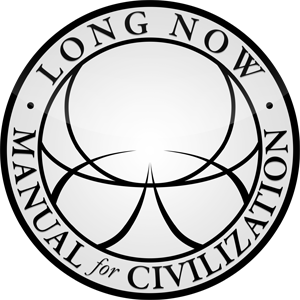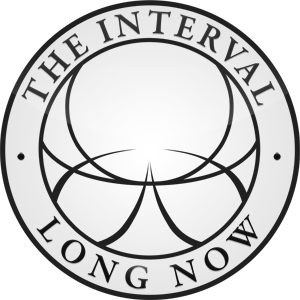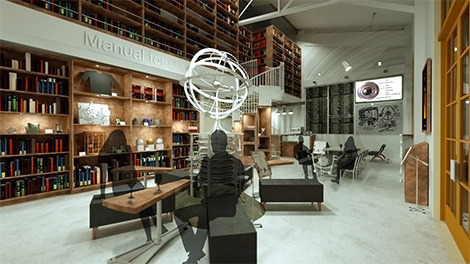Stewart Brand's Blog, page 58
March 4, 2014
Stewart Brand’s Selected Books for the Manual for Civilization
 Stewart Brand selects books from his library, photo by Alexander Rose
Stewart Brand selects books from his library, photo by Alexander Rose
Long Now’s Founding Board Member Stewart Brand suggested more than 70 volumes for our Manual for Civilization collection. The Manual will be housed within The Interval at Long Now, our new public space which opens to the public this Spring.
The 3500 books that comprise The Manual for Civilization will serve as the library component of The Interval. A dominant feature, seen immediately upon entering and even visible from outside, on shelves stretching floor to ceiling and set amongst the large scale mechanical prototypes of our 10,000-Year Clock, the Manual will present a compelling image for visitors to our space.
As construction of The Interval at Long Now nears completion, our fundraising continues. We are in the final stretch of the capital campaign to fund renovations to our San Francisco space that not only houses The Interval but also Long Now’s offices.
If this venue, it’s unique library, and all its other features capture your imagination, please consider a donation at any level. You can be a part of giving long-term thinkers a beautiful place to gather, full of amazing books. Also please spread the word to others you think would appreciate this project.
Writer, futurist, environmentalist and Long Now co-founder, Stewart Brand keeps three personal libraries. In the last month he walked us through all of them and carefully selected books for the list below. It is a remarkable list of titles old and new.
From the Epic of Gilgamesh to contemporary science fiction. Homer’s epics and Beowulf, Lao Tzu and Machiavelli. But also Brian Fagan’s The Long Summer: How Climate Changed Civilization and Thinking, Fast and Slow by Daniel Kahneman from 02011. There are many past Long Now Seminar speakers: Ian Morris, Jared Diamond, Steven Pinker and Verner Vinge to name only a few. And no less than 6 novels by the British Science Fiction author Iain M. Banks, who passed away last year.
Keep in mind that like Brian Eno’s list and others we’ll be posting soon, this is not intended as a standalone set of books, but as part of the larger corpus of thousands of texts that we are assembling. That collection will include submissions from Long Now members and the donors to our ‘brickstarter’ campaign to help build the Long Now’s Interval (formerly referred to as Long Now Salon).
Together these books assemble knowledge essential for us to maintain, extend and (if needed) recreate what humans have achieved thus far. Here are Stewart Brand’s recommendations:
Dirt: The Erosion of Civilizations by David R. Montgomery
Meditations by Marcus Aurelius
The Odyssey by Homer translated by Robert Fagles
The Iliad by Homer translated by Robert Fagles
The Memory of the World: The Treasures That Record Our History from 1700 BC to the Present Day by UNESCO
The History of the World in 100 Objects by Neil MacGregor
The Landmark Herodotus: The Histories edited by Robert B. Strassler
The Landmark Thucydides: A Comprehensive Guide to the Peloponnesian War edited by Robert B. Strassler
The Complete Greek Tragedies, Volumes 1-4 edited by David Grene and Richmond Lattimore
The Prince by Machiavelli, translated by George Bull, published by Folio Society
The Nature of Things by Lucretius
The Art of the Long View: Planning for the Future in an Uncertain World by Peter Schwartz
The Way Life Works: The Science Lover’s Illustrated Guide to How Life Grows, Develops, Reproduces, and Gets Along by Mahlon Hoagland and Bert Dodson
Venice, A Maritime Republic by Frederic Chapin Lane
The Western Canon: The Books and School of the Ages by Harold Bloom
The Map Book by Peter Barber
Conceptual Physics by Paul G. Hewitt
The Encyclopedia of Earth: A Complete Visual Guide by Michael Allaby and Dr. Robert Coenraads
The Foundation Trilogy by Isaac Asimov
Star Maker by Olaf Stapledon
The Gift: Imagination and the Erotic Life of Property by Lewis Hyde
Powers of Ten: About the Relative Size of Things in the Universe by Philip Morrison and Phylis Morrison
The Elements: A Visual Exploration of Every Known Atom in the Universe by Theodore Gray
The History of the Decline and Fall of the Roman Empire (6 Volumes) by Edward Gibbon
The Complete Guide to Trail Building and Maintenance by Carl Demrow and David Salisbury
Collapse: How Societies Choose to Fail or Succeed by Jared Diamond
A Pattern Language: Towns, Buildings, Construction by Christopher Alexander, Sara Ishikawa and Murray Silverstein
Thinking, Fast and Slow by Daniel Kahneman
The Better Angels of Our Nature: Why Violence Has Declined by Steven Pinker
Triumph of the City: How Our Greatest Invention Makes Us Richer, Smarter, Greener, Healthier, and Happier by Edward L. Glaeser
The Causes of War by Geoffrey Blainey
Military Misfortunes: The Anatomy of Failure in War by Eliot A. Cohen and John Gooch
A Short History of Nearly Everything Special Illustrated Edition by Bill Bryson
The Past From Above: Aerial Photographs of Archaeological Sites edited by Charlotte Trümpler
Turing’s Cathedral: The Origins of the Digital Universe by George Dyson
Why the West Rules–for Now: The Patterns of History, and What They Reveal About the Future by Ian Morris
The Rise of the West: A History of the Human Community by William H. Mcneill
A History of Civilizations by Fernand Braudel
The Pattern on the Stone: The Simple Ideas that Make Computers Work by Daniel Hillis
Imagined Worlds by Freeman Dyson
The Story of Writing: Alphabets, Hieroglyphs & Pictograms by Andrew Robinson
Brave New World (The Folio Society) by Aldous Huxley and illustrated by Leonard Rosoman
Dune by Frank Herbert
The Singularity is Near: When Humans Transcend Biology by Ray Kurzweil
Infinite in All Directions: Gifford Lectures Given at Aberdeen, Scotland April–November 1985 by Freeman J. Dyson
What Technology Wants by Kevin Kelly
The Player of Games by Iain M. Banks
Consider Phlebas by Iain M. Banks
Look to Windward by Iain M. Banks
State of the Art by Iain M. Banks
Use of Weapons by Iain M. Banks
Excession by Iain M. Banks
Across Realtime by Vernor Vinge
The Discoverers: Volumes I and II Deluxe Illustrated Set by Daniel J. Boorstin
Governing the Commons: The Evolution of Institutions for Collective Action by Elinor Ostrom
The Clash of Civilizations and the Remaking of World Order by Samuel P. Huntington
The Idea of Decline in Western History by Arthur Herman
Thinking in Time: The Uses of History for Decision Makers by Richard E. Neustadt and Ernest R. May
Finite and Infinite Games: A Vision of Life as Play and Possibility by James P. Carse
One True God: Historical Consequences of Monotheism by Rodney Stark
The Future of Life by Edward O. Wilson
The Coming Population Crash: And Our Planet’s Surprising Future by Fred Pearce
Gaia: A New Look at Life on Earth by James Lovelock
The Long Summer: How Climate Changed Civilization by Brian Fagan
Medieval Civilisation by Jacques Le Goff
The Civilization of the Middle Ages: A Completely Revised and Expanded Edition of Medieval History by Norman F. Cantor
Guns, Germs, and Steel: The Fates of Human Societies by Jared Diamond
The Eternal Frontier: An Ecological History of North America and Its Peoples by Tim Flannery
The Epic of Gilgamesh translated by Andrew George
Beowulf: A New Verse Translation by Seamus Heaney
How Buildings Learn: What Happens After They’re Built by Stewart Brand
Grand Design: The Earth from Above by Georg Gerster
The Complete Oxford Shakespeare: Histories, Comedies, Tragedies (Three volume set)
The Merck Manual Home Health Handbook by Robert Porter
Lao Tzu’s Te-Tao Ching – A New Translation Based on the Recently Discovered Ma-wang-tui Texts by Lao Tzu and translated by Robert G. Henricks
The King and the Corpse: Tales of the Soul’s Conquest of Evil by Heinrich Zimmer edited by Joseph Campbell
To add your own recommendations of books to include in The Manual for Civilization or to vote on which suggested titles should find a place on The Interval’s shelves just make a donation to support the project. We look forward to your contributions!
As we approach opening day for The Interval, we’ll continue this series of posts highlighting book lists suggested by friends and associates of Long Now for inclusion in the Manual. You can look forward to book lists from Neal Stephenson, Violet Blue, Kevin Kelly, Danny Hillis, Megan & Rick Prelinger and more.

March 3, 2014
The Interval at Long Now
Today we are proud to introduce you to The Interval. You know it already as “The Long Now Salon.” But all along we knew our new space at Fort Mason in San Francisco needed a name all its own.
The Interval will be a bar, museum, event venue, cafe, and archive. A welcoming public space and a gathering place for The Long Now Foundation’s fans, friends, and members.
An interval is a measure of time or the space between. An intervening period, a pause within time that is in a way time-less. Long Now’s mission is to foster long-term thinking and responsibility. And implicitly we want to change the way people perceive time. All times intersect at The Interval: a place for longer nows, discussing the future, enjoying the present, celebrating the past.
The Interval opens very soon, in just a matter of weeks. We need your help to complete the funding for this unique venue. Our ‘brickstarter’ campaign has raised more than two-thirds of what’s needed, but we still have about $100,000 to go as we finish construction and approach opening.
Recent progress includes installing new doors at the entrance to The Interval:
Every donation helps bring this new space to life. And we have devised some special ways to say “thanks” for your tax-deductible gift. These include special events just for donors in the first days of The Interval, Long Now gifts, and special “bottle keep” drinks at the venue. All the details are here.
Soon we’ll have exciting announcements about Brian Eno’s sound and visual design for the space, more about the Manual for Civilization, our chalkboard robot, the opening date, pre-opening events and the amazing cocktail & cafe menus we’ll be serving.
We invite you to join the list of hundreds of supporters including Long Now’s Board, past speakers, eminent authors, artists, scientists, and people around the world. Every gift helps us toward our goal.
It’s an honour to help @Longnow in its mission to make people think about the long term (& to put up a library shelf) http://t.co/zTSN7DWAL9
— Neil Gaiman (@neilhimself) July 9, 2013

Mariana Mazzucato Seminar Tickets
The Long Now Foundation’s monthly
Seminars About Long-term Thinking

Mariana Mazzucato presents
“The Entrepreneurial State:
Debunking Private vs. Public Sector Myths”
TICKETS
Monday March 24, 02014 at 7:30pm SFJAZZ Center
Long Now Members can reserve 2 seats, join today! General Tickets $15
About this Seminar:
Where do the boldest innovations, with the deepest consequences for society, come from?
Business leaders, entrepreneurs, and libertarians claim that the private sector leads the way always, and government at best follows by decades and at worst impedes the process with bureaucratic regulations.
Mariana Mazzucato proves otherwise. Many of the most profound innovations—from the Internet and GPS to nanotech and biotech —had their origin in government programs developed specifically to explore innovations that might eventually attract private sector interest. Governments can take on multi-decade, slow-payoff, ambitious projects where most businesses cannot. The process works pretty well now. How can it work better?
Mazzucato is a professor of the Economics of Innovation at Sussex University and author of The Entrepreneurial State: debunking private vs. public sector myths.

February 28, 2014
Brian Eno’s Selected Books for the Manual for Civilization
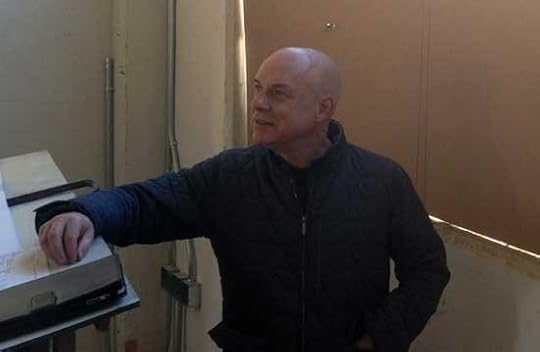
Brian Eno visited San Francisco to see the site where the Manual for Civilization shelves will be
Photo by Alexander Rose
Twenty books suggested by Long Now’s Founding Board Member Brian Eno form the first in a series of reports on additions to our Manual for Civilization collection. This library will eventually include 3,500 books you would most want to sustain or rebuild civilization. The Manual needs your help to get built! Please make a donation so we can purchase these books and the shelves they go on. The Manual will be a central feature of our new space that opens later this year. Here are Brian Eno’s recommendations:
Seeing Like a State by James C Scott
The Mind in the Cave: Consciousness and the Origins of Art by David Lewis-Williams
Crowds and Power by Elias Canetti
The Wheels of Commerce by Fernand Braudel
Keeping Together in Time by William McNeill
Dancing in the Streets by Barbara Ehrenreich
Roll Jordan Roll by Eugene Genovese
A Pattern Language by Christopher Alexander et al
The Face of Battle by John Keegan
A History of the World in 100 Objects by Neil MacGregor
Contingency, Irony and Solidarity by Richard Rorty
The Notebooks by Leonardo da Vinci
The Confidence Trap by David Runciman
The Discoverers by Daniel Boorstein
Mother Nature: A History of Mothers, Infants, and Natural Selection by Sarah Hrdy
War and Peace by Leo Tolstoy
The Cambridge World History of Food (2-Volume Set) by Kenneth F. Kiple & Kriemhild Coneè Ornelas
The Illustrated Flora of Britain and Northern Europe by Marjorie Blamey & Christopher Grey Wilson
Printing and the Mind of Man by John Carter & Percy Muir
Peter the Great: His Life and World by Richard Massie
We need your help to finish this library. There are only weeks left to finish our fund raising and we need to raise at least another $100,000. Please make a donation to support this project and get direct access to the book recommendation and voting engine for the Manual for Civilization.
Some of the other contributor lists we will be sharing soon include selections from Stewart Brand, Neal Stephenson, Violet Blue, Kevin Kelly, Danny Hillis, Megan and Rick Prelinger and many more.
Once the Salon is open we hope to have events where people can argue a new book in OR out of the collection. It will be a living collection that evolves over time. The Internet Archive has generously agreed to serve as the digital backup repository of the collection so that anyone with internet access can “check out” the books, or use the list to help create their version of the archive.
You can see more about this project on the original Manual for Civilization blog post. Soon we will need to begin collecting the actual books for our shelves, and will be asking for book donations from our edited list. We hope that we can get many of these books from our community so that we don’t have to purchase too many new books.

Brian Eno’s Selected Books for The Manual for Civilization

Brian Eno visited San Francisco to see the site where The Manual for Civilization shelves will be
Photo by Alexander Rose
Twenty books suggested by Long Now’s Founding Board Member Brian Eno form the first in a series of reports on additions to our Manual for Civilization collection. This library will eventually include 3,500 books you would most want to sustain or rebuild civilization. The Manual will be a central feature of the Long Now public space that opens later this year. Here are Brian Eno’s recommendations:
Seeing Like a State by James C Scott
The Mind in the Cave: Consciousness and the Origins of Art by David Lewis-Williams
Crowds and Power by Elias Canetti
The Wheels of Commerce by Fernand Braudel
Keeping Together in Time by William McNeill
Dancing in the Streets by Barbara Ehrenreich
Roll Jordan Roll by Eugene Genovese
A Pattern Language by Christopher Alexander et al
The Face of Battle by John Keegan
A History of the World in 100 Objects by Neil MacGregor
Contingency, Irony and Solidarity by Richard Rorty
The Notebooks by Leonardo da Vinci
The Confidence Trap by David Runciman
The Discoverers by Daniel Boorstein
Mother Nature: A History of Mothers, Infants, and Natural Selection by Sarah Hrdy
War and Peace by Leo Tolstoy
The Cambridge World History of Food (2-Volume Set) by Kenneth F. Kiple & Kriemhild Coneè Ornelas
The Illustrated Flora of Britain and Northern Europe by Marjorie Blamey & Christopher Grey Wilson
Printing and the Mind of Man by John Carter & Percy Muir
Peter the Great: His Life and World by Richard Massie
We need your help to finish this library. There are only weeks left to finish our fund raising and we need to raise at least another $100,000. Please make a donation to support this project and get direct access to the book recommendation and voting engine for the Manual for Civilization.
Some of the other contributor lists we will be sharing soon include selections from Stewart Brand, Neal Stephenson, Violet Blue, Kevin Kelly, Danny Hillis, Megan and Rick Prelinger and many more.
Once the Salon is open we hope to have events where people can argue a new book in OR out of the collection. It will be a living collection that evolves over time. The Internet Archive has generously agreed to serve as the digital backup repository of the collection so that anyone with internet access can “check out” the books, or use the list to help create their version of the archive.
You can see more about this project on the original Manual for Civilization blog post. Soon we will need to begin collecting the actual books for our shelves, and will be asking for book donations from our edited list. We hope that we can get many of these books from our community so that we don’t have to purchase too many new books.

February 27, 2014
Colonel Matthew Bogdanos Seminar Media
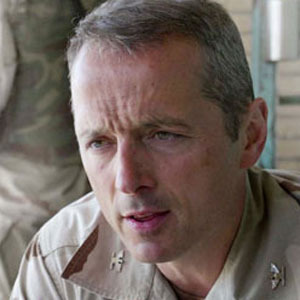 This lecture was presented as part of The Long Now Foundation’s monthly Seminars About Long-term Thinking.
This lecture was presented as part of The Long Now Foundation’s monthly Seminars About Long-term Thinking.
The Unlooting of Civilization’s Treasures in Wartime Iraq
Monday February 24, 02014 – San Francisco
Because the talk revolves around and discusses the specifics of what is still an on-going investigation, there will not be any recording of any kind–audio or visual, of this Seminar. Thank you for your understanding.
*********************
Unlooting the Iraq Museum – a summary by Stewart Brand
Iraq’s National Museum in Baghdad had been closed to the public by Saddam Hussein for over two decades when his regime fell in April 02003. Iraqis felt no connection to the world renowned cultural treasures inside. Like every other government building, it was trashed and looted.
Marine Col. Matthew Bogdanos, then in Basra leading a counter-terrorism group, volunteered part of his team to attempt recovery of the lost artifacts. He arrived at the museum with 14 people to protect its dozen buildings and 11 acres in a still-active battle zone. Invited by the museum director, they took up residence and analyzed the place as a crime scene.
Missing were some of civilization’s most historic archeological treasures. From 3200 BC, the Sacred Vase of Warka, the world’s oldest carved stone ritual vessel. From 2600 BC, the solid gold bull’s head from the Golden Harp of Ur. From 2250 BC, the copper Akkadian Bassetki Statue, the earliest known example of lost-wax casting. From 3100 BC, the limestone Mask of Warka, the first naturalistic depiction of a human face. From 800 BC, the Treasure of Nimrud— a fabulous hoard of hundreds of pieces of exquisite Assyrian gold jewelry and gems. Plus thousands of other artifacts and antiquities, including Uruk inscribed cylinder seals from 2500 BC.
Bidding on the international antiquities black market went to $25,000 for Uruk cylinder seals, $40 million for the Vase of Warka.
Since the goal was recovery, not prosecution, Bogdanos instituted a total amnesty for return of stolen artifacts—no questions asked, and also no payment, just a cordial cup of tea for thanks. Having learned from duty in Afghanistan to listen closely to the locals, Bogdanos and his team walked the streets, visited the mosques, played backgammon in the neighborhoods, and followed up on friendly tips (every one of which turned out to be genuine). 3,000 items had been taken from the museum by random looters. Local Iraqis returned 95% of them.
The prime pieces stolen by professional thieves took longer to track down. Raids on smuggler’s trucks and hiding places turned up more items. The Bassetki Statue was found hidden in a cesspool; the Mask of Warka had been buried in the ground. Some pieces began turning up all over the world and were seized when identified. (Bogdanos noted that Geneva, Switzerland, is where that kind of contraband often rests in warehouses that law enforcement is not allowed to search.)
It turned out Saddam himself had looted the museum of the Treasure of Nimrud and the gold bull’s head back in 01990. Tips led to a flooded underground vault in the bombed-out Central Bank of Iraq, and the priceless items were discovered.
Everything found was returned to the Iraq National Museum, where the great antiquities are gradually being restored to public display. Iraq, and the world, is retaking possession of its most ancient heritage.
Bogdanos quoted Sophocles: “Whoever neglects the arts… has lost the past and is dead to the future.”
(This talk was neither recorded nor filmed, because material presented in it is part of a still on-going investigation. You can get the full story from Bogdanos’ excellent book, Thieves of Baghdad.)
Subscribe to our Seminar email list for updates and summaries.

February 24, 2014
ICE/ISEE-3 To Return To An Earth No Longer Capable of Speaking To It
This August, a pioneer in space exploration returns to Earth after more than 30 years of service. The spacecraft is still in good, functioning condition, and could possibly be assigned to another mission. Sadly, however, we seem to have forgotten how to speak its language.
The probe, a collaboration between NASA and ESA, was one of three crafts launched in 01978 to study the the interaction between solar wind and Earth’s magnetosphere. Named the International Sun-Earth Explorer-3 (ISEE-3), it was the first-ever object to be sent into heliocentric orbit at the first Lagrangian point – a particular location between Earth and Sun, where our planet’s gravitational force cancels out the Sun’s pull in such a way that a satellite essentially orbits in tandem with Earth.
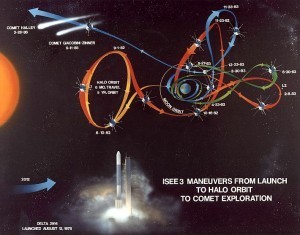 Upon completion of its mission in 01983, the probe was repurposed and re-christened: now called the International Cometary Explorer (ICE), it circled the moon a few times to gather speed, and then flew off to chase after two comets. ICE intercepted comet Giacobini-Zinner in 01985 before catching up with Halley’s comet in 01986, and making history as the first spacecraft to study two comets directly.
Upon completion of its mission in 01983, the probe was repurposed and re-christened: now called the International Cometary Explorer (ICE), it circled the moon a few times to gather speed, and then flew off to chase after two comets. ICE intercepted comet Giacobini-Zinner in 01985 before catching up with Halley’s comet in 01986, and making history as the first spacecraft to study two comets directly.
After a brief third mission to study coronal mass ejections, NASA officially decommissioned the probe and shut down communications with its systems. Nevertheless, the agency discovered in 02008 not only that ICE had failed to power off, but also that 12 of its 13 instruments were still functioning. They entertained the idea of sending ICE off to study another corner of the Solar System – only to learn that the equipment needed to communicate with ICE is no longer available, and too cost-prohibitive to rebuild. The Planetary Society’s Emily Lackdawalla explains:
Several months of digging through old technical documents has led a group of NASA engineers to believe they will indeed be able to understand the stream of data coming from the spacecraft. NASA’s Deep Space Network (DSN) can listen to the spacecraft, a test in 2008 proved that it was possible to pick up the transmitter carrier signal, but can we speak to the spacecraft? Can we tell the spacecraft to turn back on its thrusters and science instruments after decades of silence and perform the intricate ballet needed to send it back to where it can again monitor the Sun? The answer to that question appears to be no.
For the past 15 years, ICE has been patiently orbiting the Sun at a speed slightly higher than that of Earth. Now that it’s catching up with us again from behind, researchers realize there’s much more exploration that ICE could have helped us with. Unfortunately, we simply don’t seem capable of mustering the resources we need to communicate with ICE. Lackdawalla muses,
I wonder if ham radio operators will be able to pick up its carrier signal – it’s meaningless, I guess, but it feels like an honorable thing to do, a kind of salute to the venerable ship as it passes by.

February 20, 2014
Chris Anderson: The Makers Revolution – A Seminar Flashback
This is the debut of a new feature on our blog. A couple times a month we’ll highlight a past Long Now Seminar About Long-term Thinking (SALT). We’ll start with a talk from a year ago. Author and technologist Chris Anderson spoke about The Makers Revolution in February 02013.
Audio of our SALT series is always available free for everyone on our Seminar pages and via podcast. We host full video of the 12 most recent Seminars free for everyone, too. Long Now members can see all our Seminar videos in HD.
The Makers Revolution is a recent SALT talk. It will be free for public viewing until late March 02014.
Chris Anderson has been a journalist, author, and entrepeneur. He was the Editor in Chief of Wired Magazine, wrote for The Economist for seven years, and his books include The Long Tail, Free, and Makers: The New Industrial Revolution. He is the CEO of 3D Robotics and founder of DIY Drones.
In his Long Now talk The Makers Revolution Anderson takes us step-by-step from the 19th century Industrial Revolution to present day. Desktop publishing, PostScript, factory automation, supply chain innovation, globalization, 3D Printing, Cloud Manufacturing, and the failings of the doll house furniture industry all feature along the way. He relates his own generational maker journey: as a child learning invention & making from his father and grandfather to now manufacturing at home with his kids.
From Stewart Brand’s summary of this Seminar (in full here):
Since 02006, Maker Faires, Hackerspaces, and TechShops (equipped with laser cutters, 3D printers, and CAD design software) have proliferated in the US and around the world. Anderson said he got chills when, with the free CAD program Autodesk 123D, he finished designing an object and moused up to click the button that used to say “Print.” This one said “Make.” A 3D printer commenced building his design.
Here’s a short video clip from the Seminar:
The Seminars About Long-term Thinking series began in 02003 and is presented each month live in San Francisco. The series is curated and hosted by Long Now’s President Stewart Brand. Seminar audio is available to all via podcast.
Watch full video of this SALT talk until late March 02014. See full video of the 12 most recent Seminars on our website. Only Long Now members can access ten years of Seminars in HD. Membership starts at $8/month and includes lots of benefits. Join Long Now today.

February 14, 2014
Stewart Brand’s “SALT Summaries” Kindle Update
Since their inception in 02003, the Seminars About Long-term Thinking have featured over 100 speakers from a wide range of disciplines. Curated by Stewart Brand, each of these Seminars address some aspect of long-term thinking. From the ideas presented and discussed in the live event, he crafts a summary which captures and elucidates these ideas. A few days after a Seminar, this summary gets posted to the SALT list and blog, but we also collect these distillations in a book, “The SALT Summaries”. Every six months we update the Kindle eBook with the most recent Seminars, and we wanted to let our readers know how they can now update their Kindle book.
After you login to your Amazon account, go to the Manage Your Kindle page. On that page, you should see the cover of the book with an update option hovering above it. If you click update, the update should transfer to all of your devices. Thank you for supporting the Seminars About Long-term Thinking.

February 13, 2014
Laura Welcher Speaks at Contemporary Jewish Museum This Sunday
How do public archives, as collections of cultural artifacts, shape our collective memory? And how is this changing as new digital tools make it ever easier for scholars and artists to access these repositories?
This Sunday, Long Now’s Laura Welcher joins a group of archivists and artists to discuss these questions and more at the Contemporary Jewish Museum in San Francisco. Entitled Finders and Keepers: Archives in the Digital Age, the panel discussion accompanies an exhibit by Chicago-based photographer Jason Lazarus, who creates collaborative installations with pictures and texts submitted by others.
The panel discussion starts this Sunday, February 16th, at 3 PM; the event is free with museum admission.

Stewart Brand's Blog
- Stewart Brand's profile
- 291 followers




